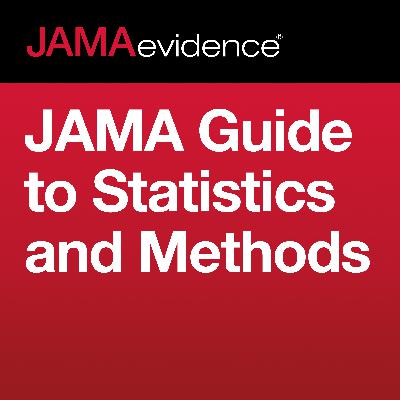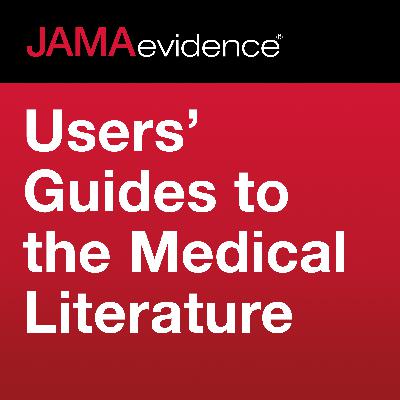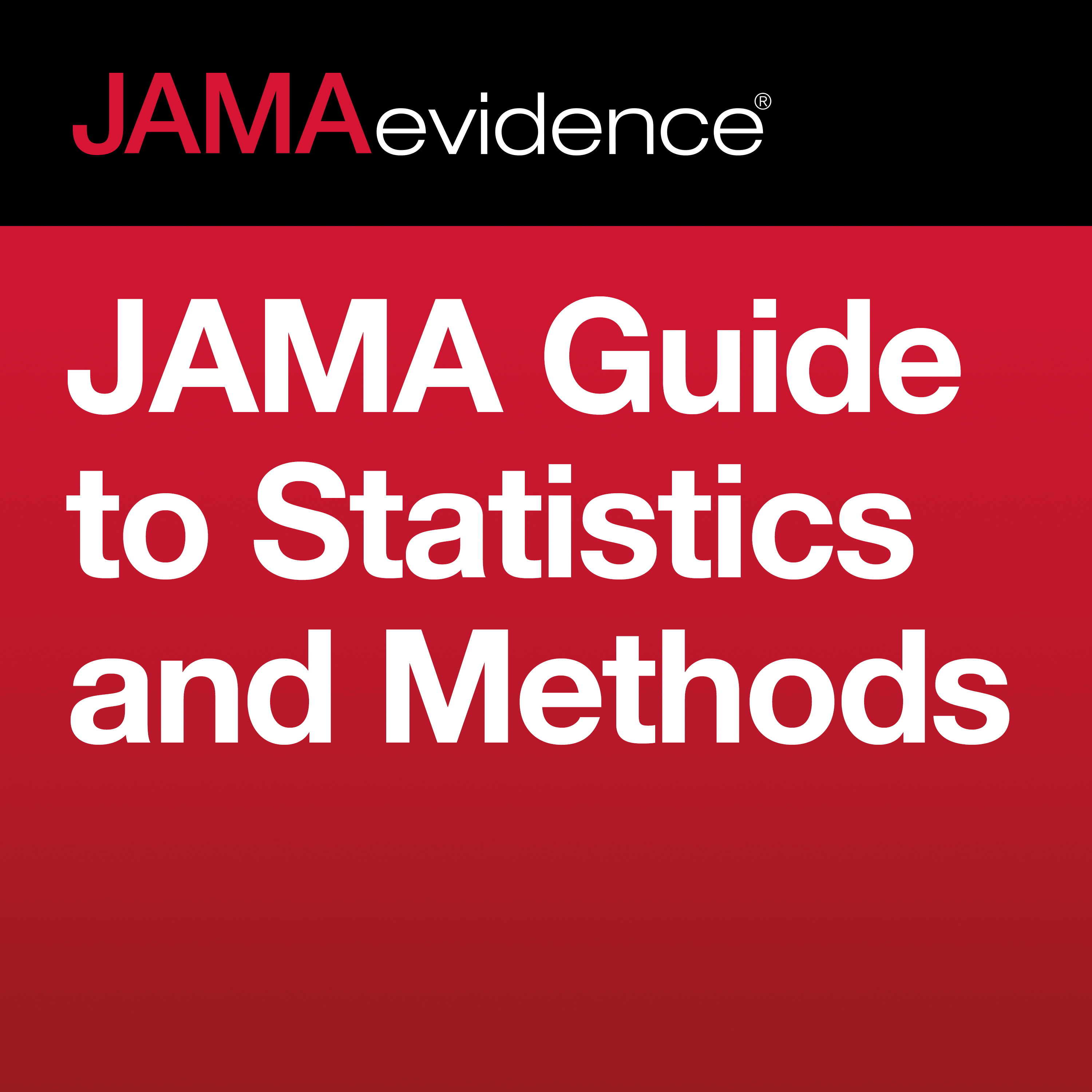Discover JAMAevidence JAMA Guide to Statistics and Methods
JAMAevidence JAMA Guide to Statistics and Methods

JAMAevidence JAMA Guide to Statistics and Methods
Author: JAMA Network
Subscribed: 125Played: 1,083Subscribe
Share
© 2020
Description
Interviews with authors of JAMA Guide to Statistics and Methods chapters about common and new statistics and methods used in clinical research and reported in medical journals.
27 Episodes
Reverse
JAMA Statistical Editor Roger J. Lewis, MD, PhD, discusses On Deep Learning for Medical Image Analysis with Lawrence Carin, PhD. Related Content: On Deep Learning for Medical Image Analysis
JAMA Statistical Editor Roger J. Lewis, MD, PhD, discusses Patient-Reported Outcome Measures in Clinical Research with Kevin P. Weinfurt, PhD, and Bryce B. Reeve, PhD. Related Content: Patient-Reported Outcome Measures in Clinical Research
JAMA Statistical Editor Roger J. Lewis, MD, PhD, discusses Immortal Time Bias in Observational Studies with Kabir Yadav, MDCM, MS, MSHS. Related Content: Immortal Time Bias in Observational Studies
JAMA Statistical Editor Roger J. Lewis, MD, PhD, discusses Adjustment for Baseline Characteristics in Randomized Clinical Trial with Lars W. Andersen, MD, MPH, PhD, DMSc. Related Content: Adjustment for Baseline Characteristics in Randomized Clinical Trials
JAMA Statistical Editor Roger J. Lewis, MD, PhD, discusses Odds Ratios—Current Best Practice and Use with Edward C. Norton, PhD. Related Content: Odds Ratios—Current Best Practice and Use Types and Distribution of Payments From Industry to Physicians in 2015
Roger J. Lewis, MD, PhD, discusses Estimands, Estimators, and Estimates with Roderick J. Little, PhD, in the JAMA Guide to Statistics and Methods series. Related Content: Estimands, Estimators, and Estimates
Roger J. Lewis, MD, PhD, discusses Interpreting the Results of Intention-to-Treat, Per-Protocol, and As-Treated Analyses with Valerie A. Smith, DrPH. Related Content: Interpreting the Results of Intention-to-Treat, Per-Protocol, and As-Treated Analyses of Clinical Trials
JAMA Statistical Editor Roger J. Lewis, MD, PhD, discusses Time-to-Event Analysis with Juliana Tolles, MD, MHS. Related Content: Time-to-Event Analysis
JAMA Statistical Editor Roger J. Lewis, MD, PhD, discusses Adjusting for Nonadherence or Stopping Treatments with Amanda I. Adler, MD, PhD, and Nicholas Latimer, PhD. Related Content: Adjusting for Nonadherence or Stopping Treatments in Randomized Clinical Trials
JAMA Statistical Editor Roger J. Lewis, MD, PhD, discusses Worst-Rank Score Methods—A Nonparametric Approach to Informatively Missing Data with John M. Lachin, ScD. Related Content: Worst-Rank Score Methods—A Nonparametric Approach to Informatively Missing Data
JAMA Statistical Editor Roger Lewis, MD, PhD, discusses Using Latent Class Analysis to Identify Hidden Clinical Phenotypes with Heather G. Allore, PhD. Related Content: Using Latent Class Analysis to Identify Hidden Clinical Phenotypes With Dr Heather G. Allore
JAMA Statistical Editor Roger Lewis, MD, PhD, discusses Use of Run-in Periods in Randomized Trials with Jane M. Armitage, MBBS. Related Content: Use of Run-in Periods in Randomized Trials With Dr Armitage Short- and Long-term Effects of a Mobile Phone App in Conjunction With Brief In-Person Counseling on Physical Activity Among Physically Inactive Women: The mPED Randomized Clinical Trial
JAMA Statistical Editor Roger Lewis, MD, discusses Regression Discontinuity Design with Matthew L. Maciejewski, PhD. Related Content: Regression Discontinuity Design Using Instrumental Variables to Address Bias From Unobserved Confounders
JAMA Statistical Editor Roger Lewis, MD, discusses Case-Control Studies: Using “Real-world” Evidence to Assess Association, With Dr Irony.
Roger J. Lewis, MD, PhD, discusses Equipoise in Research—Integrating Ethics and Science in Human Research with Alex John London, PhD Related Content: Equipoise in Research—Integrating Ethics and Science in Human Research
Roger J. Lewis, MD, PhD, discusses Bayesian Analysis: Using Prior Information to Interpret the Results of Clinical Trials with Melanie Quintana, PhD Related Content: Bayesian Analysis: Using Prior Information to Interpret the Results of Clinical Trials Effect of Therapeutic Hypothermia Initiated After 6 Hours of Age on Death or Disability Among Newborns With Hypoxic-Ischemic Encephalopathy: A Randomized Clinical Trial Incorporating Adult Evidence Into Pediatric Research and Practice: Bayesian Designs to Expedite Obtaining Child-Specific Evidence
Cost-effectiveness analysis defines trade-offs between costs, harms, and benefits of alternative treatments and combines them into a single metric, the incremental cost-effectiveness ratio (ICER), that can inform decisions about which interventions to recommend when limited resources are available. Gillian Sanders-Schmidler, PhD, professor of population health sciences and medicine at Duke University, explains the method in terms clinicians can understand. Related Article: Cost-effectiveness Analysis for Clinicians
JAMA Deputy Editor Edward Livingston, MD, discusses "Multiple Comparison Procedures" with Dr. Jing Cao, PhD
Logistic regression is one of the most commonly used statistical analytic tools in the medical literature. William Meurer, MD, from the University of Michigan, and Juliana Tolles, MD, from UCLA, discuss a JAMA Guide to Statistics and Methods article they wrote entitled “Logistic Regression Diagnostics: Understanding How Well a Model Predicts Outcomes.” Related Article: Logistic Regression
Roger J. Lewis, MD, PhD, discusses Randomization in Clinical Trials from the JAMA Guide to Statistics and Methods Related Article(s): Randomization in Clinical Trials












